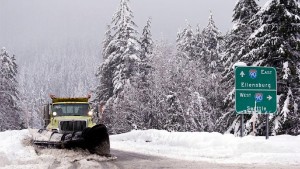
Snow storm damage: Photo credit: AP /Elaine Thompson
Snow Storm Damage occurs when substantial amounts collect or when wind drifts collections into larger piles. Mountainous terrain is particularly susceptible to snow storm damage when heavy piles trigger avalanches. Cornices, overhanging ramps of drifted snow, are also likely to build, crack and eventually dangerously collapse, particularly during warmer, sunnier weather. You might want to look at a past story that we have done on blizzards.
December 2015 brought with it record snowfalls for Washington, Oregon and the Cascades, which caused massive snow storm damage and closed major passes before Christmas. In lieu of the winter of 2014-15, the worst ski season ever, a record-breaking 193.3 inches of early season snowfall has hit Snoqualmie Pass. A record 7-day snowfall of 112 inches was experienced on the 18th – 24th. In Seattle, it wasn’t cold enough for snow but, with 11.21’’, it was the second wettest December on record, missing 1979’s by 0.64’’.
About two weeks ago, strong winds and heavy snow hit New Mexico, western Texas and the Oklahoma panhandle. As the storm pushed northeast, midwestern States were blasted by heavy icing, rain, snow, sleet and freezing rain. Life-threatening flooding from heavy rains and widespread melting plagued Texas, all the way to the Ohio Valley. Severe thunderstorms pounded the lower Mississippi valley. Tornadoes were even spotted, especially around Dallas-Ft. Worth.
The infamous polar vortex is set to send storms toward the US January 10-15 but will remain well to the north, minimizing its impact. The central and eastern US will avoid the bitterly cold temperatures that lie on its northern side but will be in the line of the storm track. Strong ridges of high pressure are building over northern Siberia, Alaska and western Canada, all the way to Greenland. Together, the atmospheric barriers will push the polar vortex into southeastern Canada. The Arctic Oscillation and the North Atlantic Oscillation indices have been falling into the negatives, which is telltale of incoming colder weather. After the cold snap, seasonal temperatures will return with the arrival of the trough that’s presently pushing through the Gulf of Alaska.
<p.
Story written by Meteorologist Geoff Linsley